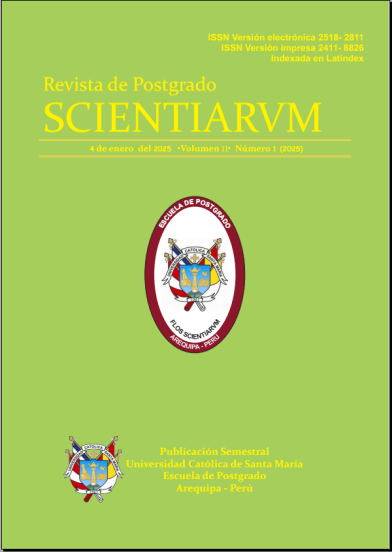PREVALENCIA Y HABITOS DE CONSUMO DE DROGAS EN LOS ESTUDIANTES DE LA UNIVERSIDAD CATÓLICA DE SANTA MARÍA
Carlos Alberto Medina Pomareda1 , Alberto Cáceres Huambo1
(1)Universidad Católica Santa María
RESUMEN: El consumo de drogas en nuestro país es de suma preocupación, convirtiéndose en uno de los problemas de Salud Pública que según las estadísticas, muestran tendencias ascendentes en los adolescentes y jóvenes; sector muy vulnerable y que fácilmente se convierten en usuarios del alcohol y tabaco en un inicio, para luego ingresar al consumo de drogas más nocivas.
En la presente investigación transversal con 965 estudiantes con el objetivo fundamental de encuestar electrónicamente a los alumnos de la Universidad Católica Santa María de las diferentes áreas académicas respecto al consumo de sustancias psicoactivas lícitas e ilícitas.
La investigación demostró que el consumo de sustancias psicoactivas lícitas e ilícitas en la comunidad de la Universidad Católica Santa María, muestra que el consumo de alcohol (96.4%) fue más frecuente que el tabaco (58.5%) y en el caso del consumo de sustancias psicoactivas ilícitas se demuestra que el 46.0% de los universitarios consumen al menos una sustancia tóxica, en la que predomina la marihuana. En cuanto a los hábitos se encontró que la edad de inicio del consumo de tabaco fue entre los 17 a 18 años, con una frecuencia de uno a tres cigarrillos diarios con el objeto de lograr gusto y relajamiento acompañando esta actitud con la ingesta de licor.
Los hallazgos también nos demuestran que el consumo de alcohol se inicia entre los 15 y 16 años durante los fines de mes, prefiriendo la ingesta de cerveza malta en casa de amigos, para pasarla bien y evitar malestares físicos. Con respecto al consumo de sustancias psicoactivas, la investigación reporta que esta se inicia por encima de los 17 años con ketes de marihuana (69.1%) con un consumo no menor de un año en casa de amigos, accediendo a estos tóxicos en el entorno de la universidad, señalando la curiosidad como motivo principal y consumiendo generalmente estas sustancias en fiestas de la universidad.
Palabras claves: Droga, psicoactivo, marihuana, estudiante.
ABSTRACT: Drug consumption in our country is extremely worrying, becoming one of the public health problems that according to statistics, show increasing trends in adolescents and young adults; very vulnerable sector and easily become users of alcohol and snuff at first, and then enter the consumption of more dangerous drugs.
In this cross-sectional survey with 965 students with the basic objective of electronically surveying students at the Catholic University of Santa María academic areas regarding the use of licit and illicit psychoactive substances.
The research showed that the use of licit and illicit psychoactive substances in the community of Santa Maria Catholic University, shows that consumption of alcohol (96.4%) was more frequent than snuff (58.5%) and in the case of substance illicit psychoactive shows that 46.0% of college consume at least one toxic substance, which is dominated by marijuana. As habits found that the age of first use of snuff was between 17 to 18 years, with a frequency of one to three cigarettes a day in order to achieve pleasure and relaxation accompanying this attitude with the intake of liquor.
The findings also demonstrate that the alcohol starts between 15 and 16 years during the end of the month, preferring intake malt beer friends house to hang out and prevent physical ailments. With regard to substance use, research reports that this starts over 17 years ketes marijuana (69.1%) with no less than one year consumption at friends, accessing these toxic environment college, pointing curiosity as the main reason and usually consume these substances in college parties.
Keywords: Drugs, psychoactive marijuana student
Revista Seleccionada
Junio 2015 Volumen 1 - Número 1 P 71-74
DOI: 10.26696/sci.epg.0015
Enlaces
EDITORIAL
CIENCIAS SOCIALES Y HUMANIDADES
ÉTICA Y RESPONSABILIDAD DEL POLÍTICO EN EL ESTADO DE DERECHO
La tecnociencia en el contexto ético-social
REFLEXIONES SOBRE LA CRISIS DEL DISCURSO DE LA RAZON EN LA POSMODERNIDAD
TÉCNICAS DE REPRODUCCION ASISTIDA: RESPONSABILIDAD DE LA BIOÉTICA Y LA BIOTECNOLOGÍA
CIENCIAS BIOLÓGICAS Y DE SALUD
AUTOAGRESION DELIBERADA Y NIVELES DE DEPRESION EN ADOLESCENTES DE DOS INSTITUCIONES EDUCATIVAS


